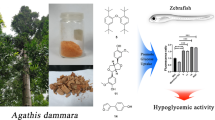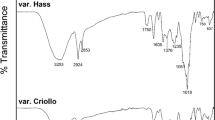Phytochemical study of the root bark of Paeonia suffruticosa plant led to the isolation and characterization of paeoniflorigenone (1), benzoylpaeoniflorin (2), betulinic acid (3), oleanolic acid (4), β-sitosterol (5), and caffeic acid octadecyl ester (6). The enzymatic activities of compounds 1-6 were evaluated by in vitro inhibition assay of α-glucosidase and α-amylase. Compounds 1-6 with IC50 values ranging from 30 to 180 μM inhibited α-glucosidase more efficiently than the standard compound acarbose (IC50 = 1463.0 ± 29.5 μM). Conversely, these compounds (with IC50 values ranging from 40 to 200 μM) were less potent against α-amylase compared to acarbose (IC50 = 16.6 ± 0.9 μM). Kinetic analysis showed that compound 1 was a mixed-type inhibitor, compounds 3 and 4 were noncompetitive inhibitors, while compound 6 was an uncompetitive inhibitor of glucosidase.


Similar content being viewed by others
References
D. Y. Hong and K. Y. Pan, J. Syst. Evol., 37(4), 351 – 368 (1999).
S. Wu, D. Wu, and Y. Chen, Chem. Biodivers., 7(1), 90 – 104 (2010).
L. Zhang, D. C. Li, and L. F. Liu, Int. Immunopharmacol., 72, 413 – 421 (2019).
Y. Y. Wang, C. Y. Wang, S. T. Wang, et al., Food Chem., 345, 128765 (2021).
N. Cho, J. Shaw, S. Karuranga, et al., Diabetes Res. Clin. Pract., 138, 271 – 281 (2018).
S. J. Heo, J. Y. Hwang, J. I. Choi, et al., Eur. J. Pharmacol., 615(1 – 3), 252 – 256 (2009).
H. Ding, X. Wu, J. Pan, et al., J. Agric. Food Chem., 66(27), 7065 – 7075 (2018).
A. Demir, H. Turumtay, M. Emirik, et al., Med. Chem. Res., 28(12), 2232 – 2245 (2019).
M. Fomogne-Fodjo, D. Ndinteh, D. Olivier, et al., J. Ethnopharmacol., 195, 238 – 245 (2017).
D. Quaglio, S. Corradi, S. Erazo, et al., ACS Med. Chem. Lett., 11(5), 760 – 765 (2020).
N. T. Hiep, J. Kwon, D. W. Ki m, et al., Tetrahedron, 73(19), 2747 – 2759 (2017).
J. C. Menezes, N. Edraki, S. P. Kamat, et al., J. Agric. Food Chem., 65(33), 7228 – 7239 (2017).
L. Okutan, K. T. Kongstad, A. K. Jager, et al., J. Agric. Food Chem., 62(47), 11465 – 11471 (2014).
Y. S. Lin, C. R. Chen, W. H. Wu, et al., J. Agric. Food Chem., 63(28), 6393 – 6401 (2015).
V. Morocho, A. Valle, J. Garcia, et al., Molecules, 23(1), 146 (2018).
Y. Meng, A. Su, S. Yuan, et al., Plant Foods Hum. Nutr., 71(4), 444 – 449 (2016).
L. Zeng, G. Zhang, S. Lin, et al., J. Agric. Food Chem., 64(37), 6939 – 6949 (2016).
Y. Q. Li, F. C. Zhou, F. Gao, et al., J. Agric. Food Chem., 57(24), 11463 – 11468 (2009).
H. Ding, X. Hu, X. Xu, et al., Int. J. Biol. Macromol., 107, 1844 – 1855 (2018).
L. Zeng, H. Ding, X. Hu, et al., Food Chem., 271, 70 – 79 (2019).
Acknowledgments
The authors thank Ms Lih-Mei Sheu and Ms Shu-Chi Lin, Instrumentation Centre of the College of Science, National Chung Hsing University and National Tsing Hua University for mass spectrometry (MS) measurements. The nuclear magnetic resonance spectroscopy (NMR) measurements were performed in the Precision Instruments Centre of the National Pingtung University of Science and Technology.
FUNDING
This work was supported by the Ministry of Science and Technology of Taiwan (Grants MOST 105-2320-B-020-002-MY3 and MOST 108-2320-B-020-003) and NPUST-KMU Joint Research Project (KP-109005).
CONFLICT OF INTEREST
The authors declare that they have no conflicts of interest.
Author information
Authors and Affiliations
Corresponding authors
Rights and permissions
Springer Nature or its licensor holds exclusive rights to this article under a publishing agreement with the author(s) or other rightsholder(s); author self-archiving of the accepted manuscript version of this article is solely governed by the terms of such publishing agreement and applicable law.
About this article
Cite this article
Chen, PC., Dlamini, B.S., Chen, CR. et al. Inhibitory Potential of Chemical Constituents from Paeonia suffruticosa Against α-Glucosidase and α-Amylase. Pharm Chem J 56, 821–826 (2022). https://doi.org/10.1007/s11094-022-02715-x
Received:
Published:
Issue Date:
DOI: https://doi.org/10.1007/s11094-022-02715-x




